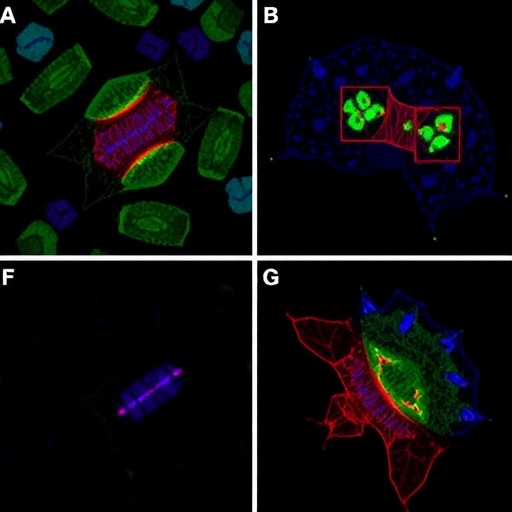Recent advancements in the realm of neurobiology have unveiled the potential of neural stem cell-derived exosomes as formidable agents in combatting neurodegenerative diseases, particularly Parkinson’s disease. The research conducted by Guo et al. represents a pivotal contribution to our understanding of how these extracellular vesicles derived from neural stem cells can mitigate the effects of neurotoxin-induced complications in mouse models. Through an intricate examination of the mechanisms involved, the findings promise to illuminate potential therapeutic pathways that could be harnessed for human applications.
Parkinson’s disease, characterized by the degeneration of dopaminergic neurons in the substantia nigra, has long presented a challenging puzzle for neuroscientists and medical practitioners alike. The etiology of this disorder is multifactorial, encompassing genetic predispositions, environmental exposures, and complex biochemical pathways. In this context, MPTP (1-methyl-4-phenyl-1,2,3,6-tetrahydropyridine) is a potent neurotoxin utilized in research models to mimic the symptoms and cellular pathology associated with Parkinson’s disease. The administration of MPTP has been instrumental in revealing insights into the neurodegenerative processes, specifically the induction of oxidative stress and inflammation.
Within this investigative framework, Guo and colleagues explored the role of exosomes secreted by neural stem cells. These nano-sized extracellular vesicles are composed of lipids, proteins, and nucleic acids, functioning as critical mediators of intercellular communication. The study hypothesizes that exosomes derived from neural stem cells could serve as vehicles to deliver neuroprotective factors that counteract the detrimental effects of MPTP exposure. By employing a well-established mouse model, the researchers meticulously evaluated the therapeutic efficacy of these exosomes as agents capable of reversing neurotoxic damage.
The experimental design entailed administering MPTP to a cohort of mice, thereby inducing parkinsonian symptoms such as impaired locomotion and body posture abnormalities. Following the establishment of the disease model, the scientists proceeded with the isolation of exosomes from cultured neural stem cells. These exosomes were then administered intravenously to the MPTP-treated mice, establishing a basis for assessing their therapeutic benefits. The results were promising—mice receiving exosome treatment displayed significant improvements in motor function, marked by enhanced mobility and precision in movement.
At a cellular level, the protective effects of exosome therapy were attributed to several key mechanisms. The study highlighted the ability of these exosomes to modulate inflammatory responses, reducing the expression of pro-inflammatory cytokines that exacerbate neuronal damage. Furthermore, the researchers observed a noteworthy increase in neuronal survival rates and a decrease in apoptotic markers in the brain tissue of treated mice, suggesting that exosomes might confer a neuroprotective effect by promoting cell viability and mitigating necrosis.
Additionally, the influence of exosomes on neurotransmitter levels was examined. The research team reported that exosome treatment led to restored levels of dopamine in the striatum, a critical brain region heavily implicated in Parkinson’s pathophysiology. This restoration of neurotransmitter balance is essential for the alleviation of motor deficits commonly experienced by individuals with Parkinson’s disease. The multifaceted approach to studying the effects of exosomes underscores their potential as a novel therapeutic strategy in neurodegeneration.
Investigations into the molecular cargo of the exosomes revealed the presence of numerous neuroprotective proteins and signaling molecules. These findings point to the complex interplay of biomolecules contained within exosomes, which can influence cellular processes and potentially modify disease trajectories. Understanding the specific components responsible for these protective effects remains a crucial area for future research; it could elucidate mechanisms that may be manipulated for therapeutic advantage.
While the implications of this study are significant, the journey from bench to bedside remains fraught with challenges. Key among these is the need to fine-tune exosome isolation and characterization protocols, ensuring consistency and reproducibility for therapeutic applications. Moreover, any future clinical translation of these findings will necessitate rigorous safety and efficacy assessments to ascertain the potential of exosomes as a treatment modality for Parkinson’s disease.
The exploration of exosome therapy is not solely limited to Parkinson’s disease; it opens avenues for research into other neurodegenerative conditions. The regenerative capabilities of neural stem cells, coupled with their secretory profiles, may yield fruitful insights for a variety of neurological disorders characterized by similar pathophysiological mechanisms. Innovations in this domain could ultimately reshape therapeutic approaches across a spectrum of diseases.
As research in the field of neural stem cells and exosome biology continues to advance, collaborative efforts among neuroscientists, clinicians, and biotechnologists will be critical. The integration of multidisciplinary perspectives will be essential for optimizing exosome-derived therapies and translating them into clinical practice. Community engagement, public awareness, and patient perspectives will also play indispensable roles in the processes that guide research priorities and funding allocations.
In summary, Guo et al.’s research on neural stem cell-derived exosomes marks a significant step forward in our understanding of potential treatments for Parkinson’s disease. The mechanistic insights, therapeutic prospects, and future research directions indicated by this study could usher in a new era of neurorestoration strategies. By leveraging the inherent capabilities of neural stem cells and their secreted exosomes, the scientific community may one day overcome longstanding challenges in treating neurodegenerative diseases.
Ultimately, the findings echo a clarion call for the continued exploration of cellular communication mechanisms through exosome therapy, paving pathways for novel, effective interventions against Parkinson’s disease and beyond. As we await further studies to corroborate these results, the promise of exosome-based therapies shines brightly, auguring a hopeful future for those affected by neurological disorders.
Subject of Research: Effects of neural stem cell-derived exosomes on Parkinson’s disease
Article Title: Effects of neural stem cell-derived exosomes on MPTP-induced Parkinson’s disease in mice
Article References: Guo, X., Xing, J., Shi, X. et al. Effects of neural stem cell-derived exosomes on MPTP-induced Parkinson’s disease in mice. Sci Nat 112, 53 (2025). https://doi.org/10.1007/s00114-025-02002-1
Image Credits: AI Generated
DOI: https://doi.org/10.1007/s00114-025-02002-1
Keywords: neural stem cells, exosomes, Parkinson’s disease, MPTP, neurodegeneration, neuroprotection, extracellular vesicles, dopamine restoration, inflammatory response, cell viability.




